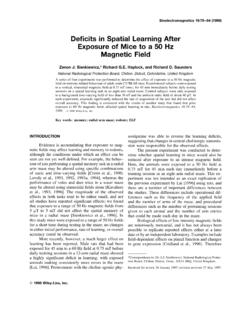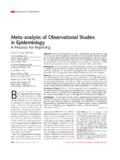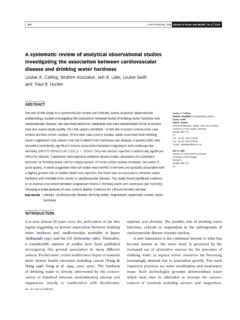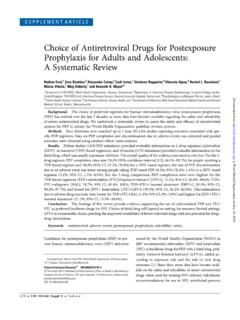Transcription of Extremely low-frequency electromagnetic fields …
1 EPIDEMIOLOGYE xtremely low- frequency electromagnetic fields exposureand female breast cancer risk: a meta- analysis basedon 24,338 cases and 60,628 controlsChunhai Chen Xiangyu Ma Min Zhong Zhengping YuReceived: 8 January 2010 / Accepted: 30 January 2010 Springer Science+Business Media, LLC. 2010 AbstractExposure to Extremely low- frequency electro-magnetic fields (ELF-EMF) has been suggested to increasefemale breast cancer risk; however, the data have beeninconclusive. In order to derive a more precise estimationof the relationship, a meta- analysis was performed. Med-line, PubMed, Embase, the Cochrane Library and Web ofScience were searched.
2 Crude ORs with 95% CIs wereused to assess the strength of association between ELF-EMF exposure and female breast cancer risk. A total of 15studies published over the period 2000 to 2009 including24,338 cases and 60,628 controls were involved in thismeta- analysis . The results showed no significant associa-tion between ELF-EMF exposure and female breast cancerrisk in total analysis (OR= , 95% CI= ) and in all the subgroup analyses by exposure modes,menopausal status, and estrogen receptor status. This resultis in accordance with the previous meta- analysis carriedout by Erren in 2000.
3 In conclusion, this meta-analysissuggests that ELF-EMF exposure has no association withthe susceptibility of female breast low-frequencyelectromagnetic fields Female breast cancer Meta- analysis Cancer riskIntroductionOver the past three decades, potential health effects ofexposure to electromagnetic fields have been extensivelyinvestigated in epidemiologic studies. These studies havesuggested an association between occupational and resi-dential exposure to Extremely low- frequency electromag-netic fields (ELF-EMF) and cancer risk, and theInternational Agency for Research on Cancer evaluated theassociation in 2002 and concluded that ELF-EMF arepossibly carcinogenic to humans, based on the associationof higher level residential magnetic fields and increasedrisk for childhood leukaemia.
4 The evidence for an associ-ation with breast cancer in women was, however, consid-ered to be inadequate [1].Breast cancer is the second most common cancer overallin the world and accounts for an estimated 16% of totalcancer among women. However, the etiology of breastcancer remains poorly understood. The possible relationbetween ELF-EMF exposure and risk of breast cancer inwomen has received considerable attention and extensivelystudies. ELF-EMF are electric and magnetic fields withfrequencies ranging between 3 and 3000 Hz. ELF-EMFexposures may occur at work, through residential proxim-ity to electromagnetic field sources, or within homes, andthe primary exposure frequency is power frequency .
5 Theubiquity of ELF-EMF in houses, offices, and factoriesmeans that nearly everyone is likely to be exposed to somelevel of ELF-EMF. Even a modest EMF-attributable breastcancer risk could thus result in a considerable number ofChunhai Chen and Xiangyu Ma contributed equally to this Chen M. Zhong Z. Yu (&)Faculty of Preventive Medicine, Department of OccupationalHealth, Key Laboratory of electromagnetic RadiationProtection, Third Military Medical University,Chongqing 400038, Chinae-mail: MaFaculty of Preventive Medicine, Department of Epidemiology,Third Military Medical University, Chongqing 400038, China123 Breast Cancer Res TreatDOI analysis of the evidence regarding a possible asso-ciation between ELF-EMF and breast cancer is therefore ofinterest not only because it may contribute to a betterunderstanding of the etiology of breast cancer, but alsobecause of the public health implications if such an asso-ciation really date.
6 Epidemiologic studies of both residential andoccupational exposures to ELF-EMF and the risk of breastcancer have led to conflicting results. The most underlyinglimitation relates to difficulties in quantifying EMF expo-sure, as studies have often relied on proxy measures such asoccupational categories, wire codes, characteristics ofpower lines surrounding current and historical residencesrather than direct measurements of current fields as markersof past exposure. In addition, details of the methods used toclassify exposures within these broad categories differedwidely.
7 A meta- analysis of observational epidemiologicalstudies has previously been carried out by Erren [2] in 2000to examine the relationship between EMF exposure andbreast cancer. The pooled RR from the study in women (95% CI= ), and a fairly homogeneousincreased risk was found for men (RR= , 95% CI= ).Over the period 2000 2009, still extensively epidemio-logical studies have been carried out to investigate therelationship between ELF-EMF and breast cancer, espe-cially female breast cancer. Most of these studies are case control studies and focused on both residential and occu-pational exposure.
8 Several studies have investigated the useof electric bed-warming devices as a potential source ofmagnetic field exposure. Exposure levels for these differentstudies are usually measured according to the level of themagnetic field created in units of Gauss (mG; 1 Gauss=1000 mG) or Tesla (mT; mT=1 mG). These epide-miologic literatures, as summarized previously, haveyielded inconclusive results. It is still unclear whetherexposure to ELF-EMF is associated with female that the recent studies may have a high quality, itmight be important to reassess ELF-EMF exposure (both athome and at work) over the recent 10 years [3].
9 Our studyis a response to this. The purpose of the present investi-gation was to reassess the risk of female breast cancerassociated with ELF-EMF exposure in the light of theserecent publications. Thirteen case control reports focus onwomen are considered now. Subgroup analyses were car-ried out further with respect to the exposure modes, men-opausal status and estrogen receptor (ER) status. This papersupplements an earlier meta- analysis on possible associa-tions between exposures to ELF-EMF and female breastcancer. In so doing we hoped to be able to provide answersto the following questions: Could the association betweenELF-EMF and female breast cancer be confirmed?
10 Whatrecommendations can we make for further studies, ifwarranted?MethodsSearch strategy and selection criteriaThis study was performed according to the proposal ofMeta- analysis of Observational Studies in Epidemiologygroup (MOOSE) [4]. A comprehensive search strategy wasconducted towards the electronic databases includingMedline, PubMed and Embase, the Cochrane Library andWeb of Science using terms breast cancer , breastneoplasm , and electromagnetic fields over the periodJanuary 2000 to December 2009. Reference lists of theidentified articles were also examined and the literatureretrieval was performed in duplication by two independentreviewers ( Chen and Ma).









